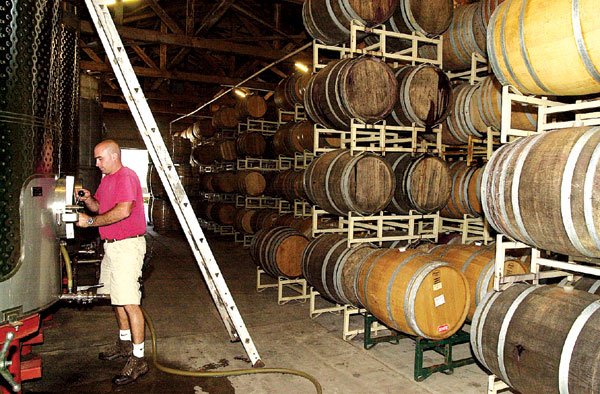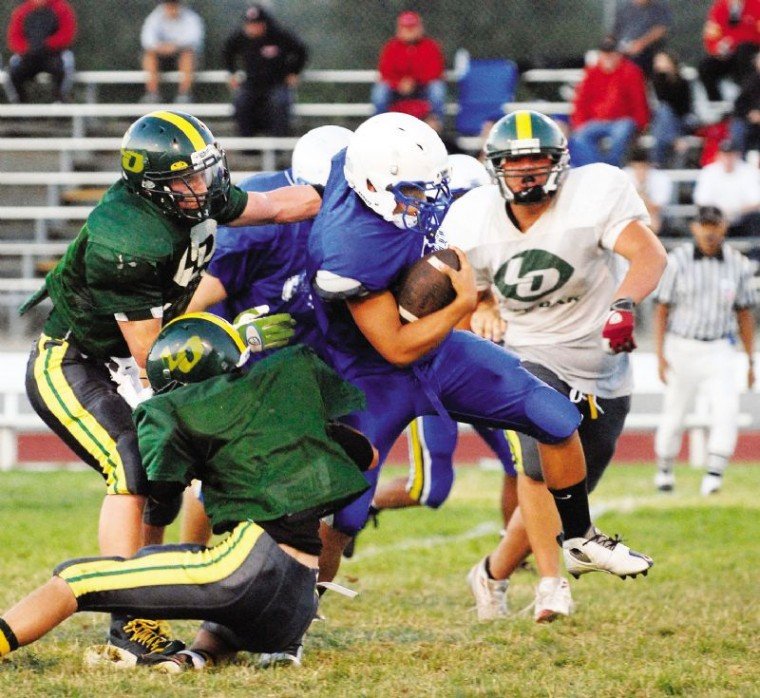GILROY
– At the Solis Winery wine-making shed Monday, Dave Vanni
watched his son Mike guide a half-ton bin of chardonnay grapes
raised by a forklift into the hopper of a grape-crushing
machine.
GILROY – At the Solis Winery wine-making shed Monday, Dave Vanni watched his son Mike guide a half-ton bin of chardonnay grapes raised by a forklift into the hopper of a grape-crushing machine.
The clamor of the machinery filled Hecker Pass that morning as a blanket of fog drifted over the redwood forests nearby. Charlie, the family’s black lab, nibbled on grapes that fell on the ground. Above him, juice and pulp traveled through a vinyl hose into a cylindrical wine press. Squeezed from the pulp, the green juice dripped into a metal trough. A taste of the thick liquid revealed its explosively sweet flavor.
With the approach of fall comes the grape harvest and crushing season, and this scene will be repeated in local wineries throughout the South County area for the next couple of months.
Last week’s heat wave that caused so many of the region’s residents to sweat was considered a true blessing for many vineyard owners.
“The hot weather helped us,” Dave said. “We need hot weather to ripen up the fruit.”
The crushing season lasts six to eight weeks, with about two harvests every week. In the long rows of grapevines, workers use small scissors to snip the chardonnay bunches off the tangled branches and then lay the fruit on small trays in the shade of the grape leaves. They work quickly and diligently, moving steadily down the rows.
Although it’s still very much a hidden treasure among California wine aficionados, the South County area is starting to bloom as a wine destination. Bonfante Gardens Theme Park along Hecker Pass has helped to bring some attention to the area’s wine industry, Dave Vanni said.
“People find out about it going to Bonfante. They drive by and say, ‘Oh, look at all the wineries.’ ” he said.
Another appeal to local vineyards is wine lovers do not have to deal with the traffic like that of Napa, he said. It’s a more leisurely drive here instead of hitting the gauntlet of Napa’s wineries.
Last year, California winemakers struggled against an oversupply of wine, both in the United States and overseas, weak economic conditions and intense foreign competition. Local vintners were no exception, Mike Vanni said.
This year’s crop at Solis will be on the “light side” – about 70 percent of normal yield – because of extensive pruning intended to raise the flavor quality of the grape, Mike Vanni said. But, that’s probably a good thing, he said.
“Everyone’s inventories have been a little high,” Mike Vanni said. “We’re just trying to scale back and wait for a rebound.”
However, he did say wine sales remain strong. Statewide, winemakers shipped 463 million gallons in 2002, increasing production by 3 percent, according to the Gomberg-Fredrikson Report.
The warm summer weather was ideal for the vines, with very little fog and cool nights creating a suitable climate for the grapes.
Mike Vanni projects Solis will produce about 5,500 cases this year. Last year’s total was about 6,500 cases, he said.
Solis sells most of its wine at its on-site tasting room, and this year’s harvest should reach the consumer in three to four years, he said.
Nov. 8 and 9, the vineyard will celebrate the harvest with a wine and cheese festival open to the public.
Across Hecker Pass Road from Solis Winery is Sarah’s Vineyard, where winemaker Dave Heiber has started his season’s harvest.
“We took in some of our pinot noir last week,” he said. “That’s fermenting in barrels.”
He expects to start harvesting the chardonnay grapes today and says the sugar content is “great” thanks to the warm days during the growing season. However, he had to really watch the mildew this year which can form during the night and damage the delicate fruit.
“It’s been cool enough so if you weren’t on top of your vineyard property, it could be a problem,” he said.
Later in the month or in early October, he expects to start harvesting zinfandel, sirah and merlot grapes as these bunches ripen.
This year’s harvest of merlot will probably be on the light side, he said. Chardonnay will yield about three to four tons per acre while the pinot noir will yield two to three tons per acre. Sarah’s Vineyard will produce a total of 2,500 to 3,000 cases – a third of which will be sold at its on-site tasting room. The rest is sold at local restaurants and the Draeger’s Quality Food Store in Menlo Park.
“I would say it’s a pretty good year because the cooler temperatures have allowed us to let the grapes stay on the vines longer,” Heiber said.
Just off Watsonville Road at Kirigin’s Cellars, workers harvested pinot noir grapes this weekend.
“It’s pretty good,” said Gracie McKeowen, tasting room manager at Kirigin’s, describing this year’s harvest. “The weather’s been good. But we had a little trouble with the deer,” she said with a laugh, describing how the wild animals like to come into the vineyard at night and nibble on the vines.
Last year’s harvest was an excellent one, and she projects this year’s will also be exceptional because conditions are equally favorable.
“I think it’s probably just as good if not better,” she said. “It’ll be comparable to last year’s.”
This year, the winery entered several of its wines at the Orange County Fair, considered the most prestigious judging event in the world for California wines, she said. Kirigin won a bronze medal for its pinot noir, a silver for its zinfandel, and a bronze for its fortified dessert wine. The vineyard sells all of its wine at its on-site tasting room which is open every day from 10 a.m. to 5 p.m.
In recent years, Mckeowen said, the South Valley wineries have developed a high reputation among wine drinkers.
“I think people are getting confidence in this area,” she said.
In Morgan Hill at the Guglielmo Winery, harvest will not start until Monday when workers bring in the zinfandel grapes, said winemaker George Guglielmo.
“Usually, I’m first, I’m the first to start,” he said.
But he wants the grape sugar content to raise just a little more on the Brix scale – which measures sugar content – to an ideal state of 24 Brix.
“We need this nice sunshine and heat during the day to get the sugars up,” he said.
Last week’s blistering heat wave, however, was too much for the grapevines and the stress of the 108-degree temperatures shut down sugar production, he said.
He sees grapes coming in through mid-October.
“The grapes look good,” he said. “We can’t tell until we start picking to see what kind of yield we’ll get and the quality we’ll get. But they look really good.”













